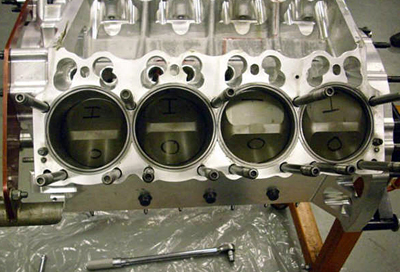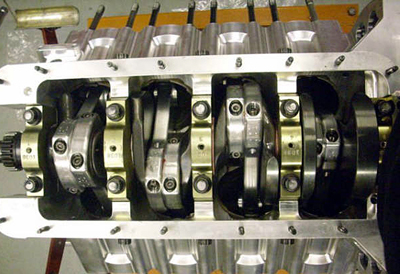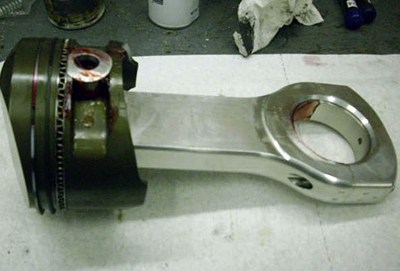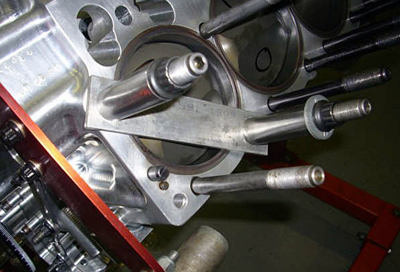So far in the A/Fuel tech series we’ve introduced you to the world of injected Fuel racing and shown you a little about the hardcore intake setup on these naturally aspirated Fuel Hemis. BangShift.com has teamed up with Veale Racing and Brown Motorsports, an A/Fuel dragster team based out of Indiana, to expose some of the secrets behind making these cars run. The Brown Motorsports guys are on a mission to spill the beans about what’s behind these snarling beasts and show once and for all that nitro racing is in fact not the inaccessible exclusive club that most of us think that it is.
In today’s installment we’re going to bring you the skinny on the short-block assembly, including the cam specs of the 420ci motor that produces several thousand horsepower on a good day. It makes lots of smoke and fire on a bad one.
The engine in these photos was the main engine used in one of the cars that the team built and tuned last season. After experiencing problems for two races in a row last year, the team used their backup mill for the remainder of the year. Once the motor was disassembled and sent to the machine shop, the guys discovered evidence that leads them to believe a bolt came out of the oil-pan baffle and was launched into the cam.
The foundation of the whole works is a Brad Anderson forged aluminum block with a 4.375-inch bore. This is a 0.500-short-deck Brad block for those of you interested in duplicating this combo in your home shop. The crankshaft is a billet Winberg piece that sports a 3.50-inch stroke. The team had the crank polished and checked for cranks by the machine shop while they were looking at the block. Obviously, any imperfections in the crank will magnify themselves in a massively destructive fashion on the track so attention to detail is very important.
The mains are all number-stamped with their position on the block, but interestingly, they are all stamped with numbers that correspond to the block they belong to, as each of these is it’s own animal and as such the caps need to stay with the block they came with in order to make sure the fit is correct. The middle (or third) main has the thrust bearing on it and the rear, of course, has the oil seal on it.
To lock down everything, the mains are torqued down to the tune of 130 ft/lbs on the bottom and the side bolts (cross bolted mains remember) get 80 ft/lbs.
All the studs used in the motor are from ARP. The head studs are HP-111 and go for short money, like $50.00 a piece. Yikes! Clevite bearings are used throughout.
Next we’ll look at the pistons that get pounded by the high-percentage loads of nitro these cars run. Brown sources his from JE (and if you want a set of exact reproductions just use Job # 668377 for a reference). They have a compression height of 1.555 inches, a pin diameter of 1.156, a pin length of 2.93 inches and a dome of 0.440 inches and they utilize three rings. In the weight department these chubby guys come in at 805 grams a piece. These cars run a compression ratio of roughly 13.5:1 as opposed to a Top Fuel Dragster which is way down in the single digits.
The connecting rods are as big and beefy as you’d expect, but it is certainly not due to high-rpm considerations, as an injected Fuel engine sees just over 6,000 rpm maximum. Top Fuel engines in the past saw more than 10,000 rpm, but in the age of rev limiters, see more like 8,500. GRP manufactures the billet aluminum rods that measure 6.951 inches. They have 2.5-inch big ends. ARP L-19 bolts torqued to 90 ft/lbs hold things together when the action starts.
The camshaft is obviously at the heart of things, and shockingly, there are several different grinds being employed by teams out there. Honestly, we figured it was basically a spec deal at this point, but there is some legitimate hot rodding going on in the cam department.
This cam is Crane (RIP) part number 66R000802. It is ground from a special 9310 steel core and is designed to be used with 0.902-inch-diameter roller lifters. Intake lobe lift is 0.540 and exhaust is 0.5003. Combine that with the 1.57:1 ratio intake rockers and 1.52:1 exhausts, and you’ve got total lift of 0.848 and 0.760 respectively. The advertised duration is 307/316. The duration at 0.050-inch tappet rise is 278/284. This particular grind is currently popular with competitors and many experiment with how it is degreed. The cam that is in the motor in the car right now (remember this is a back up) is slightly different with 2 degrees less duration, but more lift on the exhaust side. They have it installed at 25 degrees at 0.050. Basically he sets the number one piston to 25 degrees before TDC and then rotates the cam to get his 0.050 lift. The then installs the cam gears, slathers the bolts with Loctite and runs them in.

























